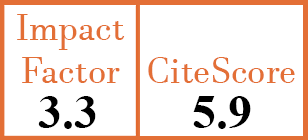Full Papers
High prevalence of metabolic syndrome in antisynthetase syndrome
P.A. Araujo1, M.G. Silva2, E.F. Borba3, S.K. Shinjo4
- Hospital das Clinicas HCFMUSP, Faculdade de Medicina, Universidade de Sao Paulo, Brazil.
- Hospital das Clinicas HCFMUSP, Faculdade de Medicina, Universidade de Sao Paulo, Brazil.
- Hospital das Clinicas HCFMUSP, Faculdade de Medicina, Universidade de Sao Paulo, Brazil.
- Hospital das Clinicas HCFMUSP, Faculdade de Medicina, Universidade de Sao Paulo, Brazil. samuel.shinjo@gmail.com
CER10526
2018 Vol.36, N°2
PI 0241, PF 0247
Full Papers
Free to view
(click on article PDF icon to read the article)
PMID: 29716676 [PubMed]
Received: 22/04/2017
Accepted : 10/07/2017
In Press: 18/04/2018
Published: 18/04/2018
Abstract
OBJECTIVES:
A high frequency of metabolic syndrome (MetS) has been recently described in different idiopathic inflammatory myopathies, but not in antisynthetase syndrome (ASS). Therefore, the aim of the present study was to determine the prevalence of MetS in ASS and also its possible association with cardiovascular the risk factors and ASS-related disease characteristics.
METHODS:
A cross-sectional single centre study of 42 consecutive ASS patients was conducted from 2012 to 2015 and compared to 84 healthy individuals matched for gender, age, ethnicity and body mass index-matched (control group). MetS was defined according to the 2009 Join Interim Statement. Clinical and laboratory data were assessed according to a standardised protocol.
RESULTS:
ASS patients had a median age of 41.1 years with a predominance of female gender and white race. ASS patients had a higher frequency of MetS (42.9% vs. 13.1%; p<0.001) as well as of insulin resistance than controls. Moreover, ASS patients had higher resistin, lower leptin and similar adiponectin levels in serum than controls. Further analysis of ASS patients with (n=18) and without (n=24) MetS revealed that older age at disease onset (48.7 vs. 35.4 years; p<0.001) was identified in those with the syndrome but were similar regarding disease duration, disease status, treatment, insulin resistance and serum adipocytokine levels.
CONCLUSIONS:
The prevalence of MetS was high in ASS patients that also had serum resistin and low leptin levels. As also identified in other idiopathic inflammatory myopathies, MetS in ASS is more prevalent in older patients.


